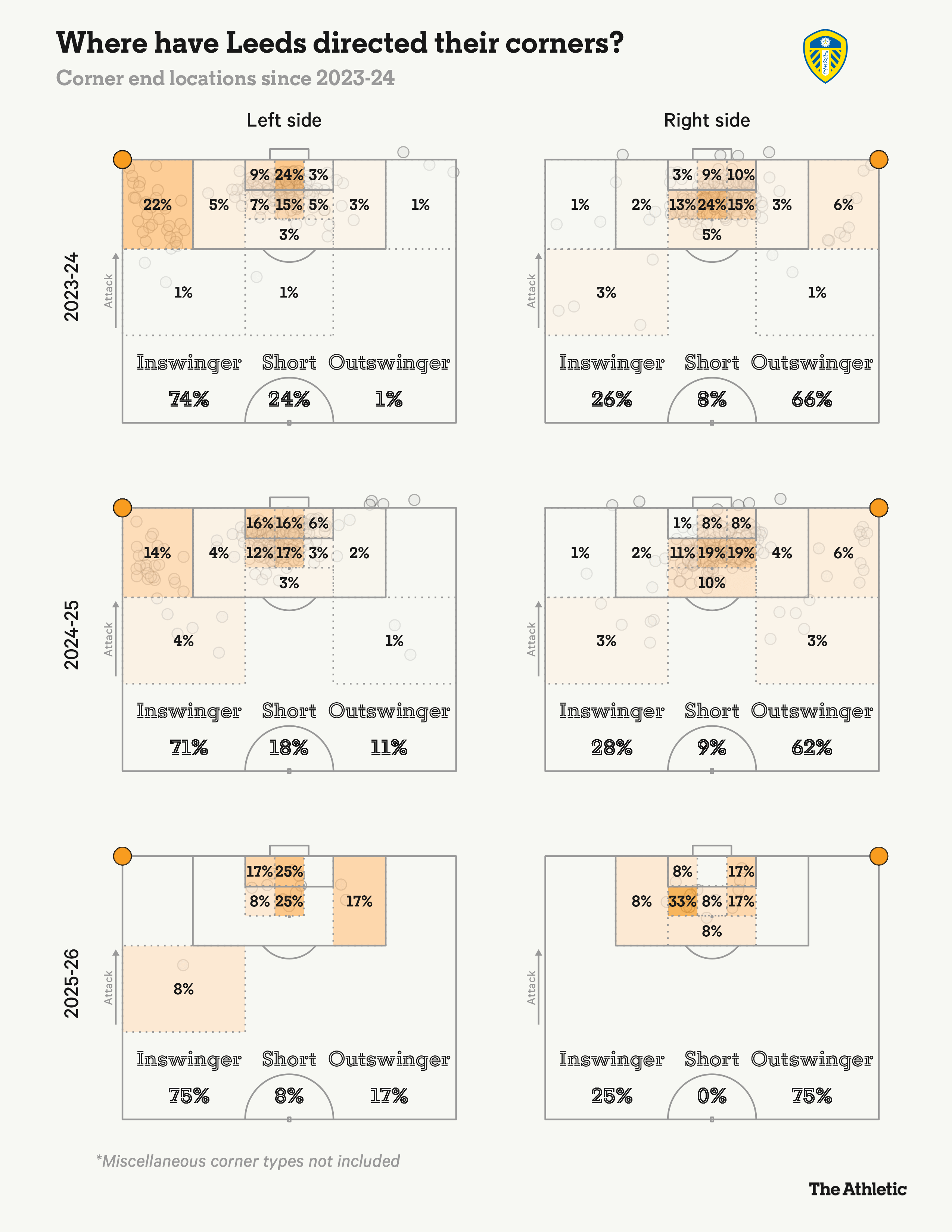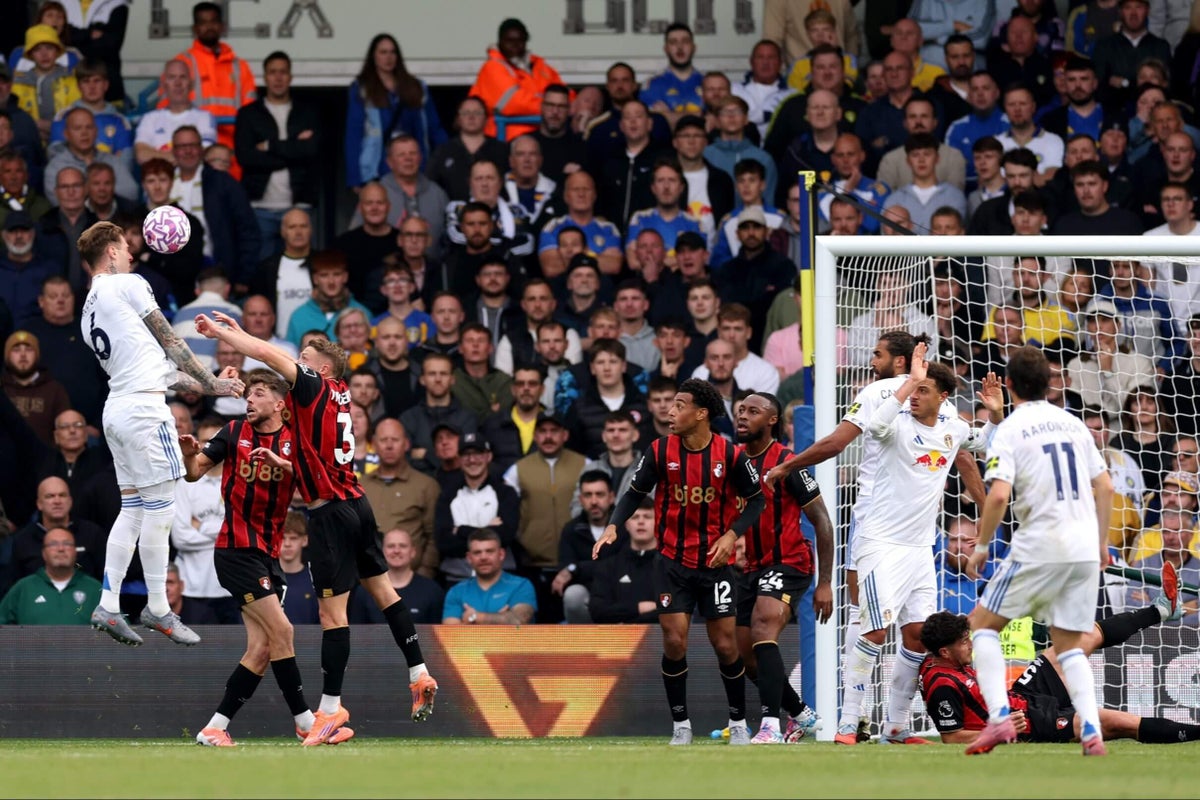It was meant to be. Fifty hours after Daniel Farke had been answering questions about Leeds United’s set-piece coaching, Joe Rodon buried a corner past Bournemouth’s Djordje Petrovic.
For such an aerially-imposing centre-back, it was, strangely, only the third senior club goal of Rodon’s career. The other two, one with Rennes and one with Leeds, were also from corners.
Juxtaposed with the comparatively killer instincts of centre-back partner Pascal Struijk, Rodon’s meagre output in the opposition penalty area has been one of the mysteries of the Farke era. The raw numbers highlight the disparity between their careers to this point: Rodon has three goals from 213 appearances, while Struijk has 11 goals (not including his three penalties) from 165 outings.
Is Struijk simply better in the air than Rodon? Not necessarily. Across their league careers, Rodon has won 63 per cent of his aerial duels, while Struijk has won 57 per cent. We know the Wales international can head a ball better than most.
Is it down to the quality of delivery or the configurations Leeds use in their set-piece routines? How can Leeds improve Rodon’s conversion rate at corners in this crucial campaign, where set pieces can level the playing field?
Can they get more from Struijk’s innate finishing ability? What are Leeds doing behind the scenes to maximise this critical route to goals in their first season back?
Farke is irked by the modern phenomenon of specialist set-piece coaches being glamourised on television and being made the centre of attention.
The manager does not have anyone in his technical area exclusively working on set pieces. Assistant coach Eddie Riemer, Farke admits, leads on this discipline, but as part of a wider team effort.
“It would be disrespectful to label it (that) we don’t have a specialist in this topic,” he said ahead of the Bournemouth game. “Edmund Riemer takes charge of it, and we have also promoted two of our guys who work in the background a bit more just on this topic, also on the grass.
“It’s still a team effort. We have the tendency, nowadays, (for) each and every corner the broadcasters have the name of the set-piece coach, always his face is in the camera and he celebrates.
“I don’t believe in this. It should still be, in general, my responsibility and sometimes, we have the tendency to produce some superstars that shouldn’t be too much in the spotlight.
“I’m not criticising any club, but I don’t believe in this so much. I believe in people who do the hard work behind the scenes.”
Arsenal’s Nicolas Jover, Chelsea’s Bernardo Cueva, Tottenham Hotspur’s Andreas Georgson and Aston Villa’s Austin MacPhee are some of the higher-profile names in such roles across the top flight. Brentford boss Keith Andrews was their set-piece guru before taking the top job in the summer.
Farke is evidently comfortable with his current arrangement, which, he points out, generated more corner goals than any other team in the Championship last season. There was some external help through 2024-25, he says.
“We have our specialists who are concentrated on working with the lads,” he said. “We had, last season, external companies we also worked together with.
“It’s a very important topic for us to be successful; otherwise, we wouldn’t be the best set-piece team last season, when we scored the most goals (via this method). On (a) Premier League level, it’s difficult to deliver it in this way.
“For example, at Wolves, we did not have one corner. It’s difficult to score out of a corner if you don’t have one, but if you score three goals out of open play, it’s also important.
“Set pieces are an important topic, Anton Stach’s free kick as an example. We have also scored out of a penalty. Both situations are important for us, and I’m pretty pleased we have good people working on it.”
Leeds scored 11 goals from corners en route to the Championship title last season, but also had more of them than any other team at 327. When you look at goals for and against per 100 set pieces across last season, United were average.

While Oxford United, Burnley and Derby County impressed with scoring more than they conceded from set pieces, Leeds marginally conceded more than they scored in these situations. There is evidently room for improvement based on last season’s output.
A deeper dive into who has been getting on the end of the team’s corners since Farke arrived makes for interesting reading, too. Unsurprisingly, Rodon and Struijk, two of the manager’s stalwarts since July 2023, have got on the end of more corners than anyone else.
What’s telling is how Struijk has made 12 fewer attempts at goal than Rodon, but generated 1.78 more in expected goals (xG), which measures the quality of a given chance. Rodon’s two goals have come from an xG of 2.91, while Struijk’s four corner strikes have come off 4.69 xG.
Most shots from corners under Farke
Rodon
98
8670
2.91
33
2
Struijk
64
5350
4.69
21
4
Byram
71
3446
1.11
15
1
Ampadu
82
7042
1.54
8
0
Firpo
61
4667
1.22
7
0
Rutter
49
4080
1.63
7
1
Bamford
50
1719
0.5
5
0
Gruev
59
3931
0.78
5
0
Piroe
93
5931
1.59
4
1
Cooper
16
714
0.14
3
1
The centre-backs are similarly under-performing on their xG at corners, but the correlation of more shots and lower xG for Rodon would suggest the chances he gets are far harder to convert when they come to him. This is due to factors such as where he is meeting the ball in the box, how many obstacles there are between him and the goal or the positioning of the goalkeeper.
What was timely about Saturday and its relation to Farke’s pre-match comments was the frequency with which Rodon was targeted at corners. His four shots and six touches in the opposition box were career highs in a league match for Rodon.
The other key change at corners was the taker. Sean Longstaff, alongside an impeccable all-round display, was on corners for the first time with his new club, and he was incredibly effective.
Before Saturday, Anton Stach, Gabriel Gudmundsson and Jack Harrison had taken responsibility for the team’s corners, but Longstaff went from none to all of them. All seven, across both sides, came from the former Newcastle United man’s right boot.

This routine of corners inswinging from the left and outswinging from the right followed the pattern we have seen under Farke since 2023-24. The sample size for this season remains too small to scrutinise convincingly, but in the last two campaigns, there has been an evident appetite for going short from the left, aside from the predictable six-yard-box targets on both sides.
Before Rodon’s goal, you can see he repeatedly flashes his fingers upwards to Longstaff, asking for it to be hung in the air for him to attack. He and Struijk begin the set piece side by side at the far corner of the area.
As the ball comes in, Rodon gets an important nudge on Adrien Truffert, which gives him the yard of space he needs to cleanly attack the ball. The left-back is left rooted, looking up as Rodon rises.

On two other examples of Rodon’s work at corners, you can see where the xG on his chances may plummet. Below, he again competes with Truffert, gets a nudge and space, but when he eventually meets the ball, he is too wide of the goal to hit the target. He does win another corner from Truffert’s block.

Here, Rodon impressively dispenses with both Truffert and Tyler Adams to free himself for the incoming corner. However, he seems to misjudge the flight of the pass and has to adjust his positioning.

Having attacked the edge of the six-yard box, Rodon has to back-pedal and meet the ball, again, wide of the goal. Unfortunately, he’s under the ball too and can only head it back into the air, instead of towards goal or the danger area.
Struijk’s yet to score this season, but his headed effort at Arsenal, from a corner, summed up the type of chances the Dutch defender typically gets. He shrugged off Bukayo Saka before meeting the ball behind Gabriel’s failed attempt to clear, forcing a point-blank save from David Raya.

Leeds and Farke may not have the designated set-piece coach that other clubs are happy to advertise, but Saturday signalled potential in the Rodon-Longstaff link-up. If the quality of Rodon’s chances can be improved and the quantity of Struijk’s upped, set pieces can be one of their key routes to survival this term.
(Top photo — Joe Rodon scoring a header from a corner against Bournemouth: Stu Forster/Getty Images)
